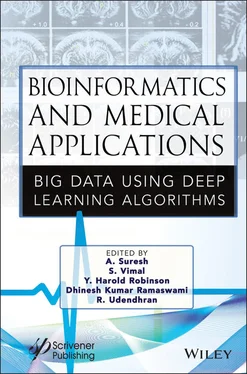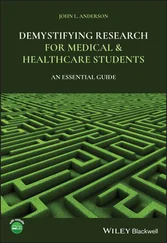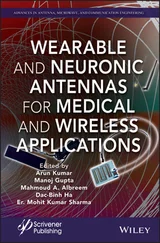Bioinformatics and Medical Applications
Здесь есть возможность читать онлайн «Bioinformatics and Medical Applications» — ознакомительный отрывок электронной книги совершенно бесплатно, а после прочтения отрывка купить полную версию. В некоторых случаях можно слушать аудио, скачать через торрент в формате fb2 и присутствует краткое содержание. Жанр: unrecognised, на английском языке. Описание произведения, (предисловие) а так же отзывы посетителей доступны на портале библиотеки ЛибКат.
- Название:Bioinformatics and Medical Applications
- Автор:
- Жанр:
- Год:неизвестен
- ISBN:нет данных
- Рейтинг книги:5 / 5. Голосов: 1
-
Избранное:Добавить в избранное
- Отзывы:
-
Ваша оценка:
- 100
- 1
- 2
- 3
- 4
- 5
Bioinformatics and Medical Applications: краткое содержание, описание и аннотация
Предлагаем к чтению аннотацию, описание, краткое содержание или предисловие (зависит от того, что написал сам автор книги «Bioinformatics and Medical Applications»). Если вы не нашли необходимую информацию о книге — напишите в комментариях, мы постараемся отыскать её.
The main topics addressed in this book are big data analytics problems in bioinformatics research such as microarray data analysis, sequence analysis, genomics-based analytics, disease network analysis, techniques for big data analytics, and health information technology.
Audience Bioinformatics and Medical Applications: Big Data Using Deep Learning Algorithms
Bioinformatics and Medical Applications — читать онлайн ознакомительный отрывок
Ниже представлен текст книги, разбитый по страницам. Система сохранения места последней прочитанной страницы, позволяет с удобством читать онлайн бесплатно книгу «Bioinformatics and Medical Applications», без необходимости каждый раз заново искать на чём Вы остановились. Поставьте закладку, и сможете в любой момент перейти на страницу, на которой закончили чтение.
Интервал:
Закладка:
The proteins expressing the SARS-CoV-2 that caused the COVID-19 pandemic have the particularity that their linear representation, i.e., their sequence, has a large number of amino acids, approximately 2,400 amino acids (aa). To give the reader an idea of the complexity and dimension of it, let us consider that some short peptides with antibacterial action have an average of 9aa.
Now, the capacity and robustness of the SARS-CoV-2 and all the regulatory processes can be dimensioned. Viruses, in general, have not simple mechanisms; they occupy some microns in length (a micron equals a thousand of a millimeters), but they are specialized organisms with multiple properly regulated functions that are characterized, among other things, for completing themselves when they are in contact with the RNA or DNA of the host.
This particularity suggests that they are not living organisms if we compare them with other living organisms whose species are known. Living organisms are born complete and do not get completed at birth; they have everything to reproduce themselves. This is not so with viruses; in any case, we can say that viruses are another type of life.
The SARS-CoV-2 is a virus of the group of coronaviruses, whose particularity and strength is the possibility of reproducing in any living organism. This feature is not shared by all viruses, e.g., the Ebola virus only passes to certain species, despite its lethality that is greater than 60%, it is less dangerous to our species because, when it kills its host, the virus dies with it and the damage is so fast that the number of deaths is small.
This does not occur with SARS-CoV-2 that can spread rapidly and the infected subject does not show any symptoms (asymptomatic) for 4 or up to 7 days, despite its lethality rate that is no higher than 2%.
From the above, it is clear that the definition of the lethality rate is not just a quotient, but multiple variables have to be considered. Almost as many as asking us about the lethality of a human being.
The review of the basic concepts related to viruses and particularly the SARS-CoV-2, make us think about the complexity of these organisms, not as organisms that by their small size are simple and potentially fragile, but as organisms with an auto-regulatory capacity as complex as the human species but in a few microns.
3.2 Human Coronavirus Types
Coronaviruses feature the crown-like spikes on their surface; they were first identified in the 1960s and there are seven types of coronavirus that infect people [1]:
1 1. 229E alpha coronavirus causes the common cold; it infects the upper respiratory tract, i.e., nose, throat, sinuses, and larynx. The subject presents symptoms within a couple of days of being in contact with the virus; these can be headache, runny nose, coughing, sore throat, and fever. The illness lasts a week or 10 days, but it can be extended up to three weeks. Sometimes, subjects with other health problems develop pneumonia [2].
2 2. OC43 beta coronavirus is also the cause of common cold, and just like the 229E, it infects the upper respiratory tract and affects the same organs. The symptoms are also the same as well as the recovery time. Subjects with other health problems can develop pneumonia too [2].
3 3. NL63 alpha coronavirus causes many common symptoms and diseases; it infects the upper and lower tract and can cause croup and bronchiolitis [3].
4 4. MERS-CoV, the beta coronavirus, is the cause of Middle East Respiratory Syndrome or MERS; the symptoms are coughing, shortness of breath, and fever. Sometimes, the subject can also present pneumonia and gastrointestinal symptoms, such as diarrhoea. Some laboratory-confirmed cases of MERS-CoV are reported asymptomatic, i.e., the subjects do not present symptoms. Most of these cases are detected after a thorough tracing of laboratory-confirmed cases [4].
5 5. HKU1 beta coronavirus causes upper respiratory diseases with common cold symptoms and the subject can develop pneumonia and bronchiolitis [5].
6 6. SARS-CoV, the beta coronavirus, causes severe acute respiratory syndrome (SARS), it starts with a high fever, more than 38°C, the subject presents chills, headache, and muscle pain; some cases have mild respiratory symptoms, and some patients have diarrhoea.
7 7. Within a week, the subject presents a dry cough or dyspnoea that can progress to hypoxemia. Some cases even require intubation and mechanical ventilation. The white blood cell count decreases and many people have low platelet counts [6].
8 8. SARS-CoV-2, the novel coronavirus which is the cause of COVID-19, affects people in different ways. In most cases a moderate illness is present and the subject recovers without hospitalization. The symptoms are fever, tiredness, dry coughing, aches and pains, diarrhoea, headaches, conjunctivitis, rash on the skin, and loss of taste or smell. There could also be difficulty breathing, chest pain, and loss of speech or movement [7].
3.3 The SARS-CoV-2 Pandemic Impact
The SARS-CoV-2 and the COVID-19 disease impact is a multifactorial phenomenon to measure it we have to take into account some factors ( Section 3.1), so let us only take two of them for the moment; its dissemination capacity and its capacity to kill a human being.
The propagation of viruses has to do with the possibility of passing to any organism and the SARS-CoV-2 virus gets this feature from the Coronaviridae family ( Section 3.3.2), which can be considered very high; on the other hand, the lethality of the SARS-CoV-2 is no higher than 2% ( Section 3.1), which is low.
However, both factors together create a combination that strongly impacts humans, as their propagation and lethality take on a large number of lives, given the permanence of the virus in human beings.
In this sense, the impact is very high since this coronavirus has a very similar spread to any flu; however, its lethality is very high compared to this disease, as up to date there is no effective treatment or vaccine available; unlike the A H1N1 influenza pandemic in 2009 that had an effective treatment and the vaccine was available few months later.
In this regard, any alert or official warning that the population is facing an epidemic process or a pandemic, in general, has to do with a minimum number of people infected that have had a microbiological corroboration.
In the case of an unknown illness, this verification can take days or even weeks; this is a limitation that defers the notification. So, once this alert has been issued, the authorities should state it is a pandemic and not an epidemic event, according to the definition that at least two continents present infected cases, regardless of the number of them.
From the epidemiological point of view, there should be an algorithm that not only considers the number of confirmed cases, as continuous improvement of the means of transport makes contagion and dissemination of illness much faster nowadays.
3.3.1 RNA Virus vs DNA Virus
There are two main groups in the classification of viruses and they are related to the genetic material a virus uses to replicate, whether it is in a DNA or an RNA host.
DNA viruses are formed by the families (Source: [8]; change family by the corresponding family name): Adenoviridae , Papillomaviridae , Parvoviridae , Herpesviridae , Poxviridae, and Anelloviridae .
While RNA viruses are formed by the families (Source: [8]; change family by the corresponding family name): Reoviridae , Picornaviridae , Caliciviridae , Arenaviridae , Rhabdoviridae , Coronaviridae , and Herpesviridae .
Given the purpose of this chapter, the reader is invited to consult the source cited in each of the classifications, if he/she wants to delve into this topic.
Читать дальшеИнтервал:
Закладка:
Похожие книги на «Bioinformatics and Medical Applications»
Представляем Вашему вниманию похожие книги на «Bioinformatics and Medical Applications» списком для выбора. Мы отобрали схожую по названию и смыслу литературу в надежде предоставить читателям больше вариантов отыскать новые, интересные, ещё непрочитанные произведения.
Обсуждение, отзывы о книге «Bioinformatics and Medical Applications» и просто собственные мнения читателей. Оставьте ваши комментарии, напишите, что Вы думаете о произведении, его смысле или главных героях. Укажите что конкретно понравилось, а что нет, и почему Вы так считаете.












